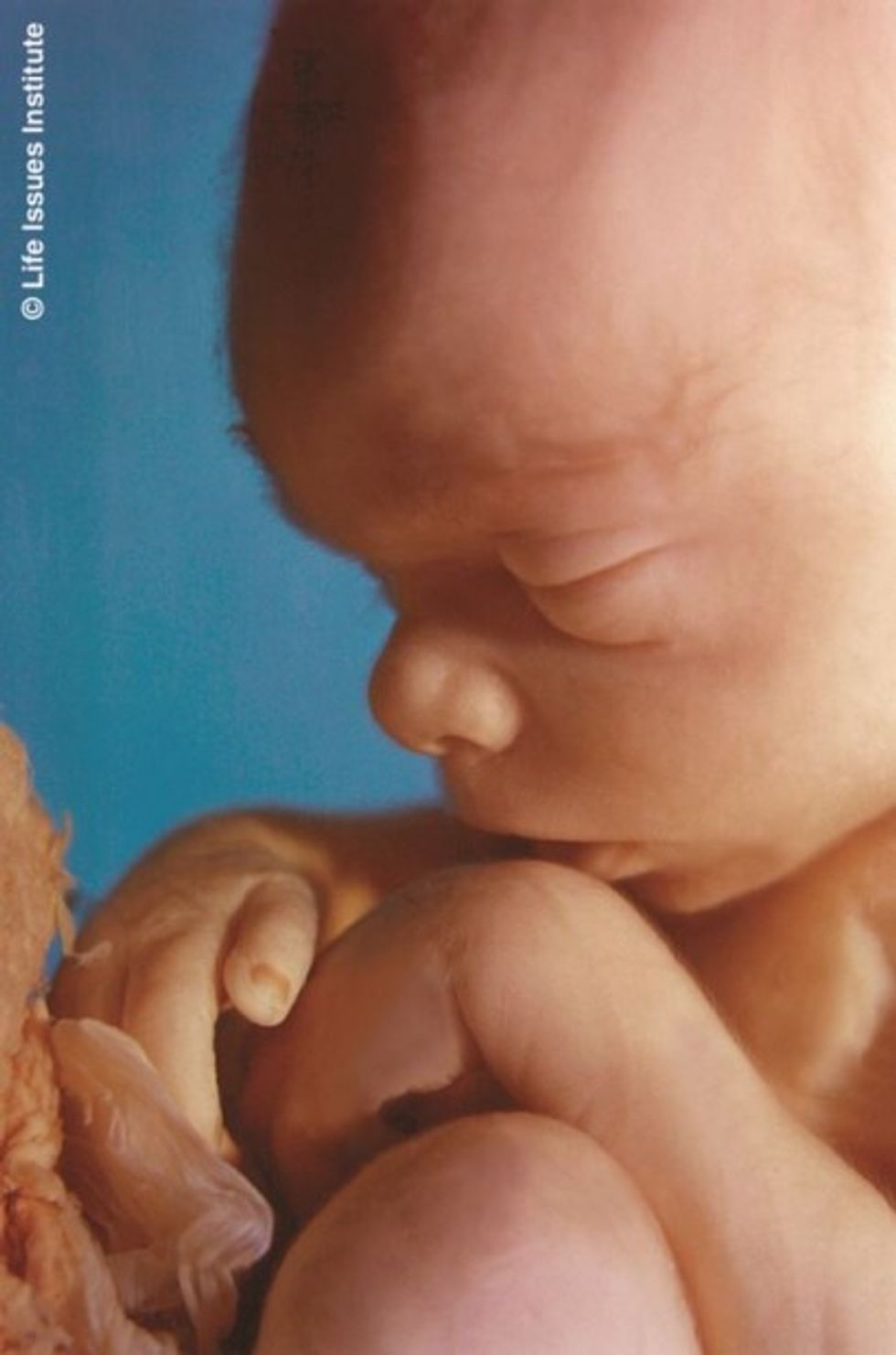
© 2025 Blaze Media LLC. All rights reserved.
The scientific facts about fetal pain contradict what many media outlets are reporting.
The legislatures of Utah and South Carolina recently passed bills concerning abortions at 20 weeks after fertilization. This is the stage of development shown in the photograph.

Before performing abortions, the Utah bill requires physicians to anesthetize or give a painkiller to the “unborn child” once he or she reaches 20 weeks. The South Carolina bill bans abortions from this point forward. Utah’s governor has signed his state's bill into law, and South Carolina’s governor has stated she will sign her state's bill. Both of the bills contain exceptions for the life of the mother or if she has a “serious risk” of “irreversible” harm to “a major bodily function.”
According to the text of these bills, “substantial medical evidence” indicates that developing humans can feel pain by 20 weeks. This conclusion is supported by the following facts from medical journals and textbooks:
- By 7 weeks, pain “sensory receptors appear in the perioral [mouth] area.” – New England Journal of Medicine
- By 10 weeks, “All components of the brain and spinal cord are formed, and nerves link the stem of the brain and the spinal cord to all tissues and organs of the body.” – Encyclopedia of Human Biology
- By 12 weeks, “Electrical activity of the nervous system is discernible” and “attempts to suckle” are observed “in utero and in aborted fetuses.” – Encyclopedia of Human Biology
- By 14 weeks, “limb movements … become coordinated.” – Before We Are Born: Essentials of Embryology and Birth Defects
- By 14 weeks, preborn humans exhibit conscious “motor planning” and “social behavior.” – PLOS ONE
- By 14 to 22 weeks, “a physiological fetal reaction to painful stimuli” occurs. – Fetal Diagnosis and Therapy
- By 18 weeks, pain sensory receptors spread to “all cutaneous [skin] and mucous surfaces,” and the cerebral cortex (the portion of the brain responsible for higher functions like reasoning and language) has the same number of nerve cells as a full-grown adult. – New England Journal of Medicine
- By 18 to 20 weeks, the human fetus “elaborates pituitary-adrenal, sympatho-adrenal, and circulatory stress responses to physical insults.” – Anesthesiology
- By 20 weeks, the fetus “now sleeps and wakes and hears sounds.” – American Medical Association Complete Medical Encyclopedia
These scientific facts collectively show that by 20 weeks, humans have pain receptors, consciousness, and physical responses to painful events.
Nevertheless, many media outlets have recently reported that humans cannot feel pain by 20 weeks. This includes but is not limited to the New York Times, the Los Angeles Times, CNN, Slate and the Daily Beast. To support this claim, all of these outlets cited a single paper published by the Journal of the American Medical Association in 2005.
Neglecting the journalism standard to “make it clear to the audience” when sources “are associated with a particular viewpoint,” none of the outlets mentioned that at least three of the the Journal of the American Medical Association paper’s five authors have been involved in the abortion industry, including:
- Susan J. Lee, the lead author of the paper, who worked as a lawyer for the National Abortion and Reproductive Rights Action League, which is now known as NARAL Pro-Choice America.
- Eleanor A. Drey, the medical director of an abortion clinic.
- Mark Rosen, the last author of the paper, who worked in an abortion clinic. In biomedical research, the last author “is assumed to be the driving force, both intellectually and financially, behind the research.”
These media outlets also violated journalism ethics, which require them to not omit “facts of major importance or significance.” They did this by failing to reveal that the Journal of the American Medical Association paper’s central argument was refuted by medical journals less than two years after it was published. The authors of the paper declared that “fetal perception of pain is unlikely before the third trimester” because:
- “pain is a psychological construct” that requires “conscious perception.”
- there can be no “conscious recognition or awareness” until there are functional connections from pain receptors to the brain’s cortex.
- these connections don’t “begin appearing” until “23 to 30 weeks’ gestational age.” This equates to 21 weeks to 28 weeks after fertilization.
Debunking the above, a 2006 article in the journal Pain: Clinical Updates documented through “multiple lines of evidence” that the “key mechanisms” of consciousness and pain perception “are not dependent” on the cortex. Consistent with this fact, the authors determined that pain perception begins in the “second trimester” and “well before the third trimester of human gestation.”
Likewise, a 2007 paper in the journal Behavioral and Brain Sciences showed that children born with little or no cortex (a condition called hydranencephaly):
- “are conscious,” “awake,” “often alert,” and “show responsiveness to their surroundings in the form of emotional or orienting reactions to environmental events.”
- “express pleasure by smiling and laughter, and aversion by ‘fussing,’ arching of the back and crying.”
- behave so normally that they “may initially present no conspicuous symptoms,” and “occasionally the condition is not diagnosed until several months postnatally, when developmental milestones are missed.”
Concluding, the author noted that these findings have “ramifying implications for issues in medical ethics,” including “pain management in children” who lack a cerebral cortex.
False arguments aside, the vast weight of scientific evidence indicates that preborn humans can feel pain by 20 weeks or earlier. While this does not rise to the level of 100 percent certainty, it rests upon factually solid ground.
Like many media outlets, some prominent “fact checkers” have also misled the public about this issue, including FactCheck.org and the Washington Post’s Fact Checker.
James D. Agresti is the president of Just Facts, a nonprofit institute dedicated to researching and publishing verifiable facts about public policy.
–
TheBlaze contributor channel supports an open discourse on a range of views. The opinions expressed in this channel are solely those of each individual author.
Want to leave a tip?
We answer to you. Help keep our content free of advertisers and big tech censorship by leaving a tip today.
Want to join the conversation?
Already a subscriber?
more stories
Sign up for the Blaze newsletter
By signing up, you agree to our Privacy Policy and Terms of Use, and agree to receive content that may sometimes include advertisements. You may opt out at any time.
Related Content
© 2025 Blaze Media LLC. All rights reserved.
Get the stories that matter most delivered directly to your inbox.
By signing up, you agree to our Privacy Policy and Terms of Use, and agree to receive content that may sometimes include advertisements. You may opt out at any time.






